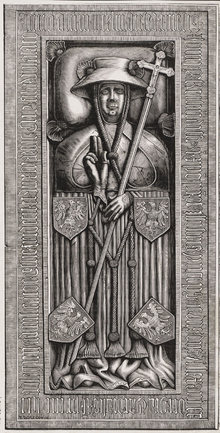Life
Beginning of his ecclesiastical career. Under the care of King Władysław II Jagiełło
Despite being the second son of his family, from early childhood Alexander was destined for a Church career. To this end, he was sent at the court of his maternal uncle, King Władysław II Jagiełło at Kraków, where under his tutelage begin his studies. Thanks to the royal protection, in 1414 he was already named Provost at Gniezno Cathedral.
During 1415-1422, Alexander assisted at the University of Kraków, where, however, wasn't an excellent student. In any case, he was unable to finish any study. Nevertheless, at the end of 1422 and thanks to being a relative of the King, he was elected honorary rector, which was contrary to the university laws.
In 1422 Władysław II Jagiełło made an unsuccessful attempt to appointed Alexander in the Bishopric of Poznań. However, the King wasn't discouraged by the failure and the following year, he managed to obtain from Pope Martin V a different diocese to him, Trento, who was located on the border between Italy and Germany. Only then Alexander decided to be ordained as priest and went on the long journey to his new diocese.
Bishop of Trento
Alexander arrived to the capital of his diocese on 25 June 1424; however, for unknown reasons his formal ordination as bishop took place only one year later, on 27 September 1425. As Bishop of Trento, he became the ruler of land strategically located on route in the foothills of the Alps.
The bishopric was widely ambitioned by his powerful neighbors, the Habsburg rulers of Tyrol, which were formally vassals of both Trento and Venice. Besides, the choice of a bishop from a far country was a big surprise for the local people and they had to accept that their new ruler would be surrounded by Polish. The choice of Alexander as bishop probably never happened if previously his sister Cymburgis had married with the Habsburg Duke Ernest I of Austria.
It is probable that the Wokabularz trydencki, the oldest preserved Latin-Polish dictionary, was made by orders of Alexander during his tenure as Bishop of Trento.
Political Independence and cooperation with Sigismund of Luxembourg
In order to maintain a relative political independence, Alexander decided to approach to the King of Germany and Hungary, Sigismund of Luxembourg, who began to politically support him. To this end, the Bishop went to Sigismund's court at Buda, from where he began tu rule his diocese.
In 1431 he took part in the expedition of Sigismund to Italy in order to obtain the imperial crown. For unknown reasons, Alexander decided not being directly involved in Sigismund's coronation at Rome, but remained in Milan, where Sigismund was also crowned King of Italy.
In subsequent years, Alexander was politically engaged in the struggle between the supporters of the primacy of the Pope over supporters of the primacy of the Council of Florence, definitely opting for the latter.
With the help of Emperor Sigismund, in 1435 he was able to finally resolve the conflict with Tyrolean ruler Frederick IV: Alexander agreed to recognize the overlordship of Tyrol in return for which was guaranteed the territorial integrity of his Bishopric.
Shortly after, his active foreign policy and the designation of several Polish in several of the Bishopric offices, caused the rebellion of the local clergy, and almost lost the power. Only with the help of Emperor Sigismund, Alexander managed to keep the control over Trento.
In 1438, Alexander entered into an alliance with Filippo Maria Visconti, Duke of Milan. This treaty did not held little benefit to Alexander; he was entangled in a war against Venice between 1440-1441.
Dispute with the Papacy and support to Antipope Felix V
Alexander's support to the Council of Florence (he even personally attended in the sessions at Basel in 1433, 1434 and 1442), brought him in December 1439 the title of Patriarch of Aquileia, while he kept the dignity of Bishop of Trento. Antipope Felix V didn't have sufficient support to implement this decision, while his opponent, Pope Eugene IV appointed to this office another candidate who actually won the power, Ludovico Trevisan. Soon after, the Council and Felix V (in order to bring the Jagiellonians and Habsburgs to their side), granted Alexander the title of Cardinal with the diocese of St. Lawrence at Damascus (12 October 1440), the Swiss Bishopric of Chur (March 1442) and finally the rectory of St. Stephen's Cathedral in Vienna. From all this appointments, Alexander was able to really take possession only of the St. Stephen's rectory.
In addition to this rich prebends, he also received from the council important diplomatic missions, but the war against Venice prevented him to participate in the Sejms of Nuremberg and Mainz, or in the disputes between Austria and Poland for the Bohemian throne.
The Anti-Turkish expedition. Death
In 1442 he arrived to Vienna, where he clashed with Eugene IV's envoy, Cardinal Julian Cesarini, who tried to encourage the local ruler, King Frederick IV of Germany to join into an anti-Turkish crusade. Being appointed by Felix V as Legate to Austria, Hungary and Poland, Alexander successfully managed to convince the German King from the unreality of these ideas. The discussion was so fierce that the Piast prince even punched Cardinal Cesarini.
After this, Alexander planned a trip to Hungary, where he hoped to persuade King Władysław III about the unreasonability of a war against the Turks. Unfortunately, during the preparations for the trip, he suddenly became ill and died on 2 June 1444. He was buried at St. Stephen's Cathedral in Vienna, where in the left of the Chancel in Frauenchor still remained his beautiful tombstone built into a wall.

Władysław III of Poland, also known as Ladislaus of Varna, was King of Poland and Supreme Duke of the Grand Duchy of Lithuania from 1434 as well as King of Hungary and Croatia from 1440 until his death at the Battle of Varna. He was the eldest son of Władysław II Jagiełło (Jogaila) and the Lithuanian noblewoman Sophia of Halshany.
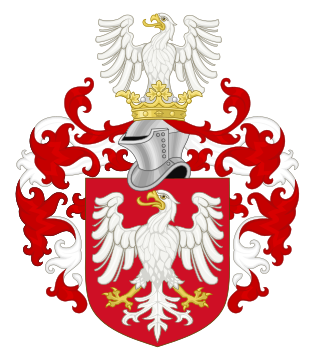
The House of Piast was the first historical ruling dynasty of Poland. The first documented Polish monarch was Duke Mieszko I. The Piasts' royal rule in Poland ended in 1370 with the death of King Casimir III the Great.
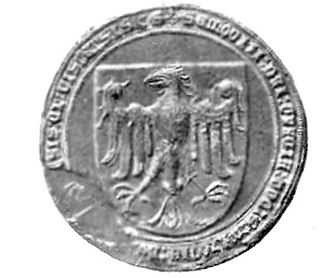
Siemowit IV, also known as Siemowit IV the Younger, was a Polish prince, member of the Masovian branch of the House of Piast and from 1373 or 1374 Duke of Rawa, and after the division of the paternal inheritance between him and his brother in 1381, ruler over Rawa, Płock, Sochaczew, Gostynin, Płońsk and Wizna, after 1386 hereditary Polish vassal, after 1388 ruler over Belz. During 1382–1401 he lost Wizna and during 1384–1399 and 1407–1411 he lost Zawkrze, during 1384–1399 he lost Płońsk, which was taken by the Teutonic Order.

Sophia of Halshany, known simply as Sonka, was a princess of Halshany who was Queen of Poland as the fourth and last wife of Jogaila, King of Poland and Supreme Duke of Lithuania. As the mother to Władysław III and Casimir IV, she is the co-founder of the Jagiellonian dynasty.

Alexandra was the youngest daughter of Algirdas, Grand Duke of Lithuania, and his second wife, Uliana of Tver. Though Alexandra's exact date of birth is not known, it is thought that she was born in the late 1360s or early 1370s. In 1387, she married Siemowit IV, Duke of Masovia, and had thirteen children with him.
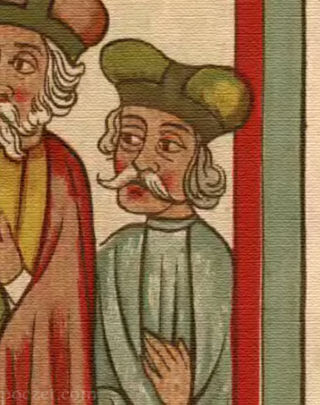
Bolesław IV of Warsaw, was a Polish prince and member of the House of Piast in the Masovian branch. He was Duke of Warsaw during 1429–1454 and sovereign Duke of Podlachia in 1440–1444.

Władysław of Głogów was a Silesian nobleman. He was the ruling Duke of Cieszyn during 1431–1442 and from 1442 sole ruler over half of both Głogów and Ścinawa.
Przemyslaus II of Cieszyn, also known as Primislaus II of Teschen or Przemko II, was a Duke of Cieszyn from 1431, ruler over Bielsko and Skoczów, Duke of half of both Duchy of Głogów and Duchy of Ścinawa from 1460 and from 1468 sole ruler over Cieszyn.
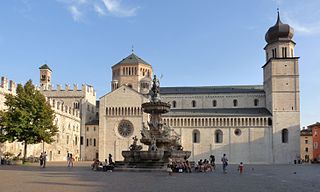
The Archdiocese of Trento is a Latin Metropolitan archdiocese of the Catholic Church in the Triveneto, named after its see in Alpine Italy, Trento, in Trentino-Alto Adige region.
Henryk IX Starszy was Duke of Żagań-Głogów from 1397 to 1412, ruler of Szprotawa, Krosno Odrzańskie from 1412 to 1417, Świebodzin and half of Głogów, from 1417 ruler of Szprotawa, half of Głogów, from 1420 ruler of Kożuchów and Zielona Góra, from 1430 ruler of Krosno Odrzańskie and Świebodzin, and from 1446 Duke of Lubin.

Konrad IV the Elder was Duke of Oels (Oleśnica), Koźle, half of Bytom and half of Ścinawa from 1412 to 1416, sharing rule with his brothers. After 1416, he became the sole ruler of Kąty, Bierutów, Prudnik and Syców. In 1417, he assumed the role of Bishop of Wrocław and also held the title of Duke of Nysa.
Euphemia of Masovia, was Duchess of Cieszyn by marriage to Bolesław I, Duke of Cieszyn, and regent of the Duchy of Cieszyn during the minority of her sons from 1431.

Bernard of Niemodlin, was a Duke of Strzelce and Niemodlin during 1382–1400, Duke of Opole during 1396–1400, from 1400 until 1450 sole ruler over Strzelce and Niemodlin, from 1401 ruler over Olesno and Lubliniec, from 1420 ruler over Prudnik and in 1424 ruler over Głogówek, during 1434–1450 ruler over Kluczbork and Byczyna and from 1450 ruler over only Olesno.
Siemowit V of Rawa, was a Polish prince member of the House of Piast from the Masovian branch. He was a Duke of Rawa Mazowiecka, Płock, Sochaczew, Gostynin, Płońsk, Wizna and Belz during 1426-1434 jointly with his brothers, and after the division of the paternal inheritance between him and his brothers in 1434, sole ruler over Rawa Mazowiecka, Gostynin and Sochaczew.

The Jagiellonian or Jagellonian dynasty, otherwise the Jagiellon dynasty, the House of Jagiellon, or simply the Jagiellons, was the name assumed by a cadet branch of the Lithuanian ducal dynasty of Gediminids upon reception by Jogaila, the Grand Duke of Lithuania, of baptism as Władysław in 1386, which paved the way to his ensuing marriage to the Queen Regnant Jadwiga of Poland, resulting in his ascension to the Crown of the Kingdom of Poland as Władysław II Jagiełło, and the effective promotion of his branch to a royal dynasty. The Jagiellons were polyglots and per historical evidence Casimir IV Jagiellon and his son Saint Casimir possibly were the last Jagiellons who spoke in their patrilineal ancestors Lithuanian language, however even the last patrilineal Jagiellonian monarch Sigismund II Augustus maintained two separate and equally lavish Lithuanian-speaking and Polish-speaking royal courts in Lithuania's capital Vilnius. The Jagiellons reigned in several European countries between the 14th and 16th centuries. Members of the dynasty were Kings of Poland (1386–1572), Grand Dukes of Lithuania, Kings of Hungary, and Kings of Bohemia and imperial electors (1471–1526).
Casimir II of Belz, was a Polish prince member of the House of Piast from the Masovian branch. He was a Duke of Płock, Rawa Mazowiecka, Gostynin, Sochaczew, Belz, Płońsk, Zawkrze and Wizna during 1426–1434 jointly with his brothers, and after the division of the paternal inheritance between him and his brothers in 1434, sole ruler over Belz.

Władysław I of Płock, was a Polish prince member of the House of Piast from the Masovian branch. He was a Duke of Płock, Rawa Mazowiecka, Gostynin, Sochaczew, Belz, Płońsk, Zawkrze and Wizna during 1426-1434 jointly with his brothers, after the division of the paternal inheritance between him and his brothers in 1434, sole ruler over Płock, Płońsk, Wizna and Zawkrze; in 1442 he reunited all their patrimony.

Jakub of Sienno was a medieval Bishop of Kraków in the years 1461–1463, Bishop of Włocławek from 1464, and then Archbishop of Gniezno from 1474. He was also a 15th-century diplomat for the Polish Crown.
